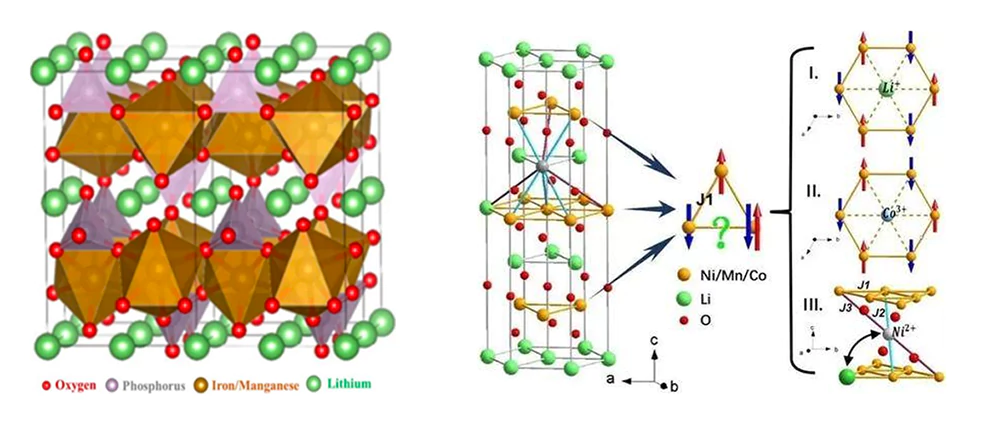1. What is lithium iron manganese phosphate?
Lithium iron manganese phosphate is a new cathode material formed by doping lithium iron phosphate with a certain amount of manganese element. Since the ionic radii and some chemical properties of manganese and iron elements are similar, lithium iron manganese phosphate and lithium iron phosphate are similar in structure, and both have an olivine structure. From the perspective of energy density, lithium iron manganese phosphate is superior to lithium iron phosphate, so it is regarded as an "upgraded version of lithium iron phosphate".
Lithium iron manganese phosphate can break through the energy density bottleneck of lithium iron phosphate. At present, the maximum energy density of lithium iron phosphate has stabilized at around 161~164Wh/kg. As a phosphate-based material with higher energy density, the application of lithium iron manganese phosphate can help break through the energy density bottleneck of lithium iron phosphate, thus ushering in industrialization opportunities.
Lithium iron manganese phosphate has advantages in energy density, safety, low temperature performance and cost.

2.Performance comparison of NCM, LFP and LFMP
|
Item |
NCM |
LFP |
LMFP |
|
Chemical formula |
Li(NixCoyMnz)O2 |
LiFePO4 |
LiMn(1-x)FexPO4 |
|
Crystal structure |
Layered structure |
Peridot |
Peridot |
|
Specific capacity(mAh/g) |
150-220 |
130-140 |
130-140 |
|
Voltage range |
3.4-3.8 |
3.4 |
4.1 |
|
Energy Density(Wh/kg) |
180-300 |
100-200 |
Higher than LFP |
|
Cycle life (times) |
800-2000 |
2000-6000 |
2000-3000 |
|
Low temperature performance |
Good |
Bad |
Better than LFP |
|
High temperature performance |
Generally |
Good |
Better than NCM |
|
safety |
Generally |
Good |
Good |
|
Material costs |
High cost |
Low costs |
Low costs |
Performance comparison table
Energy density: NCM (high nickel) > LMFP > LFP
Manganese element has the advantage of high voltage. Lithium iron manganese phosphate is doped with manganese on the basis of lithium iron phosphate to increase the voltage platform from 3.4V to 4.1V. The high voltage brings high energy density. The energy density of LMFP is 15%~20% higher than that of LFP. The energy density of LMFP can reach the level of NCM 523 or even NCM 622, which has significant advantages over LFP.
Security: LFP ≈ LMFP > NCM
LMFP crystal has a hexagonal close-packed structure. The biggest advantage of this structure is its good stability. Even if all lithium ions are detached during charging, there will be no problem of structural collapse. At the same time, the P atoms in the material form PO4 tetrahedrons through strong covalent bonds of P-O, and it is difficult for O atoms to escape from the structure, so the material has very high safety and stability.
Low temperature performance: NCM > LMFP > LFP
Nano-LFP has a capacity retention rate of about 67% at -20°C, while LMFP can maintain a capacity of 71%. When mixed with NCM materials with a mass ratio of 15%, the retention rate can reach 74%.
Production cost: NCM > LFP ≥ LMFP
From the material side, the world is rich in manganese ore reserves, and the costs of LMFP and LFP are almost the same. The manufacturing cost of LMFP is about 10% more expensive than LFP, but the energy density of LMFP can be increased by 15%. Through subsequent technology and raw material upgrades, the manufacturing cost will be at least 10% lower than LFP in the future.
|
Performance parameters |
NCM |
LFP |
LMFP |
|
Lithium ion diffusion rate(cm2/S) |
10-9 |
10-14 |
10-15 |
|
Conductivity(S/cm) |
10-3 |
10-9 |
10-13 |
Comparison of conductive properties of NCM, LFP and LFMP
3. What is the biggest bottleneck of lithium iron manganese phosphate?
Lithium iron manganese phosphate has defects in rate performance, cycle performance, etc., which hinders the advancement of industrialization. The conductivity and lithium ion diffusion rate are low, and the rate performance is relatively poor.
Crystal structure: Although the hexagonal close-packed structure of lithium iron manganese phosphate is safe and stable, there is no continuous FeO6 (MnO6) shared edge octahedron network in the material, but is connected through PO4 tetrahedrons. Therefore, it cannot form a continuous Co-O-Co structure like lithium cobalt oxide materials. The material has poor conductivity and poor high-current discharge performance. Moreover, these polyhedrons form an interconnected three-dimensional structure, restricting the movement of lithium ions in one-dimensional channels.
Metallic properties: Manganese element has relatively weak conductivity. The transition energy gap of electrons in lithium iron manganese phosphate is as high as 2eV (the transition energy gap of lithium iron phosphate is 0.3eV), which has the disadvantages of low conductivity and ion mobility.